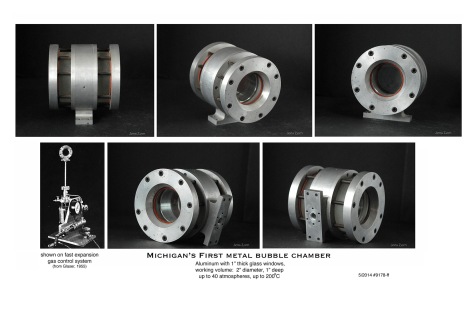P. Bubble Chamber
In 1955 Donald Glaser explored ways to encourage fast-moving charged particles to form bubbles in liquids that had been kept at moderately high pressure until the moment of the particle arrival . The release of pressure led to the formation of bubbles, much as in a carbonated beverage, and Glaser’s achievement was to construct the situation so that bubbles would form preferentially in those locations where the incoming particles had created ions within the liquid.  He then used such liquids as targets in experiments where incoming, high-energy particles were scattered. The tracks of bubbles, photographed and measured, provided an unprecedented amounts of high quality data.
He then used such liquids as targets in experiments where incoming, high-energy particles were scattered. The tracks of bubbles, photographed and measured, provided an unprecedented amounts of high quality data.
This work, done entirely at Michigan, showed the way to fundamental changes in the methods of high energy physics.  By the time Glaser was awarded the 1960 Nobel Prize for this work he had already moved, alas, to the University of California who added that prize to their list, but Glaser himself has acknowledged that Michigan can claim it also.
By the time Glaser was awarded the 1960 Nobel Prize for this work he had already moved, alas, to the University of California who added that prize to their list, but Glaser himself has acknowledged that Michigan can claim it also.
Sculpture
One maquette for consideration of an outdoor sculpture was made from a heavy aluminum ring , 18” in diameter, encircling a pattern of ribs that depict the tracks of particles found in a bubble chamber when an incoming, high energy proton creates a lambda particle and a pi-plus, pi-minus pair. If installed outside, this sculpture should be at least 48” in diameter for suitable visual affect..
Another version makes an interactive sculptuire
